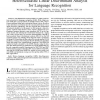Free Online Productivity Tools
i2Speak
i2Symbol
i2OCR
iTex2Img
iWeb2Print
iWeb2Shot
i2Type
iPdf2Split
iPdf2Merge
i2Bopomofo
i2Arabic
i2Style
i2Image
i2PDF
iLatex2Rtf
Sci2ools
145
Voted
TASLP
2011
2011
Time-Frequency Cepstral Features and Heteroscedastic Linear Discriminant Analysis for Language Recognition
Abstract—The shifted delta cepstrum (SDC) is a widely used feature extraction for language recognition (LRE). With a high context width due to incorporation of multiple frames, SDC outperforms traditional delta and acceleration feature vectors. However, it also introduces correlation into the concatenated feature vector, which increases redundancy and may degrade the performance of backend classifiers. In this paper, we first propose a time–frequency cepstral (TFC) feature vector, which is obtained by performing a temporal discrete cosine transform (DCT) on the cepstrum matrix and selecting the transformed elements in a zigzag scan order. Beyond this, we increase discriminability through a heteroscedastic linear discriminant analysis (HLDA) on the full cepstrum matrix. By utilizing block diagonal matrix constraints, the large HLDA problem is then reduced to several smaller HLDA problems, creating a block diagonal HLDA (BDHLDA) algorithm which has much lower computational complexi...
Related Content
| Added | 15 May 2011 |
| Updated | 15 May 2011 |
| Type | Journal |
| Year | 2011 |
| Where | TASLP |
| Authors | Weiqiang Zhang, Liang He, Yan Deng, Jia Liu, M. T. Johnson |
Comments (0)

